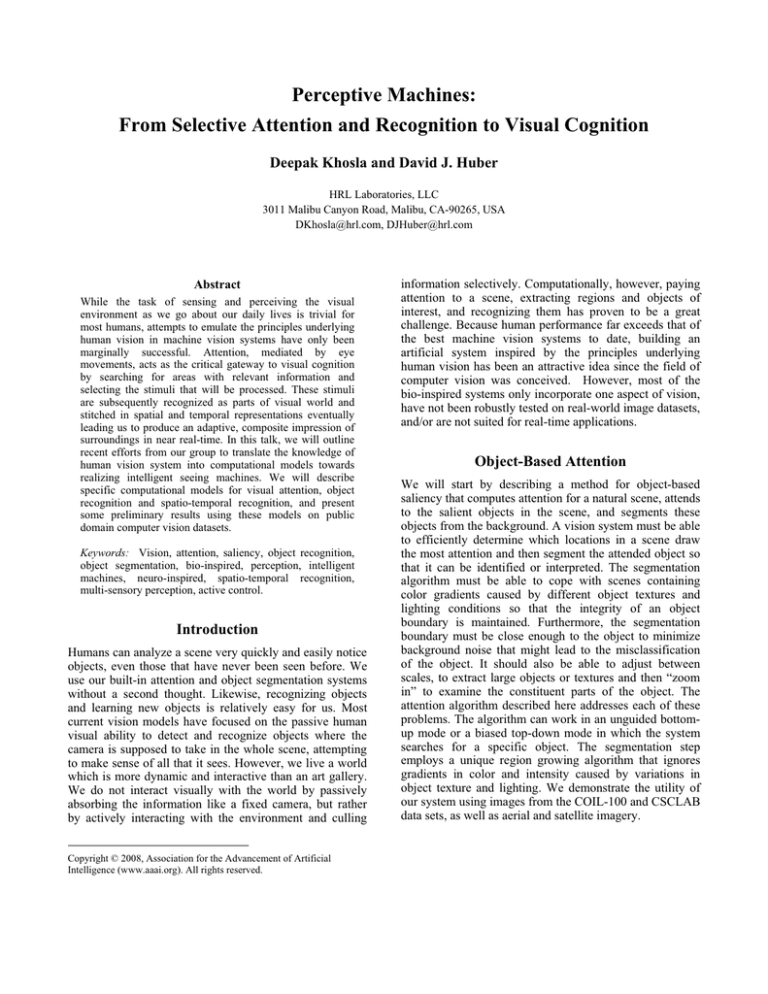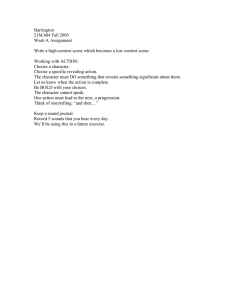
Perceptive Machines:
From Selective Attention and Recognition to Visual Cognition
Deepak Khosla and David J. Huber
HRL Laboratories, LLC
3011 Malibu Canyon Road, Malibu, CA-90265, USA
DKhosla@hrl.com, DJHuber@hrl.com
Abstract
While the task of sensing and perceiving the visual
environment as we go about our daily lives is trivial for
most humans, attempts to emulate the principles underlying
human vision in machine vision systems have only been
marginally successful. Attention, mediated by eye
movements, acts as the critical gateway to visual cognition
by searching for areas with relevant information and
selecting the stimuli that will be processed. These stimuli
are subsequently recognized as parts of visual world and
stitched in spatial and temporal representations eventually
leading us to produce an adaptive, composite impression of
surroundings in near real-time. In this talk, we will outline
recent efforts from our group to translate the knowledge of
human vision system into computational models towards
realizing intelligent seeing machines. We will describe
specific computational models for visual attention, object
recognition and spatio-temporal recognition, and present
some preliminary results using these models on public
domain computer vision datasets.
Keywords: Vision, attention, saliency, object recognition,
object segmentation, bio-inspired, perception, intelligent
machines, neuro-inspired, spatio-temporal recognition,
multi-sensory perception, active control.
Introduction
Humans can analyze a scene very quickly and easily notice
objects, even those that have never been seen before. We
use our built-in attention and object segmentation systems
without a second thought. Likewise, recognizing objects
and learning new objects is relatively easy for us. Most
current vision models have focused on the passive human
visual ability to detect and recognize objects where the
camera is supposed to take in the whole scene, attempting
to make sense of all that it sees. However, we live a world
which is more dynamic and interactive than an art gallery.
We do not interact visually with the world by passively
absorbing the information like a fixed camera, but rather
by actively interacting with the environment and culling
Copyright © 2008, Association for the Advancement of Artificial
Intelligence (www.aaai.org). All rights reserved.
information selectively. Computationally, however, paying
attention to a scene, extracting regions and objects of
interest, and recognizing them has proven to be a great
challenge. Because human performance far exceeds that of
the best machine vision systems to date, building an
artificial system inspired by the principles underlying
human vision has been an attractive idea since the field of
computer vision was conceived. However, most of the
bio-inspired systems only incorporate one aspect of vision,
have not been robustly tested on real-world image datasets,
and/or are not suited for real-time applications.
Object-Based Attention
We will start by describing a method for object-based
saliency that computes attention for a natural scene, attends
to the salient objects in the scene, and segments these
objects from the background. A vision system must be able
to efficiently determine which locations in a scene draw
the most attention and then segment the attended object so
that it can be identified or interpreted. The segmentation
algorithm must be able to cope with scenes containing
color gradients caused by different object textures and
lighting conditions so that the integrity of an object
boundary is maintained. Furthermore, the segmentation
boundary must be close enough to the object to minimize
background noise that might lead to the misclassification
of the object. It should also be able to adjust between
scales, to extract large objects or textures and then “zoom
in” to examine the constituent parts of the object. The
attention algorithm described here addresses each of these
problems. The algorithm can work in an unguided bottomup mode or a biased top-down mode in which the system
searches for a specific object. The segmentation step
employs a unique region growing algorithm that ignores
gradients in color and intensity caused by variations in
object texture and lighting. We demonstrate the utility of
our system using images from the COIL-100 and CSCLAB
data sets, as well as aerial and satellite imagery.
Object Recognition
References
We will then describe a neuro-inspired vision system that
can (1) learn representations of objects that are invariant to
scale, position and orientation; and (2) recognize and
locate these objects in static and video imagery. The
system uses modularized neuro-inspired algorithms/
techniques that can be applied towards finding salient
objects in a scene, recognizing those objects, and
prompting the user for additional information to facilitate
online learning. The neuro-inspired algorithms are based
on models of human visual attention, search, recognition
and learning. Most machine vision systems rely on
techniques that mandate offline learning and cannot learn
new classes without retraining on all prior knowledge. This
is computationally inefficient and prohibits interactive
learning. The proposed system can be trained in an online
manner, meaning that new classes and instances of classes
can be learned by the system without retraining on all prior
knowledge. The implementation is highly modular, and the
modules can be used either as a complete system or
independently. The underlying technologies were carefully
researched in order to ensure they were robust, fast, and
could be integrated into an online system. We evaluated
our system’s capabilities on the Caltech 101 and COIL 100
datasets, which are commonly used in machine vision, as
well as on simulated scenes. Preliminary results are quite
promising in that our system is able to process these
datasets with good accuracy and low computational times.
Khosla, D, Moore, C., and Huber, D. (2007). Bio-inspired
visual attention and object recognition. Proceedings of
SPIE, 6560: 656003.
Spatio-Temporal Recognition
We will describe a bio-inspired system for spatio-temporal
recognition in static and video imagery. An attention and
object recognition system is used to determine the location
and identities of objects in a scene at a particular time. A
working memory model is continuously updated with
object location and label data; it uses this data to construct
and maintain ordered spatio-temporal sequences. A bioinspired classifier ascribes event labels to these sequences.
A separate network, executed in parallel with the former,
classifies any significant spatial relations it observes
among the recognized objects. None of the algorithms in
our system require offline training, and our system can
acquire its entire knowledge base via interactive online
learning if desired. The system attempts to classify all
events that it observes. If it is not confident in its
classification, then it will query the user for the event’s
correct label and immediately acquire the new knowledge.
Unknown spatial relationships can also be interactively
learned. Our event recognition system is robust to
variations in an object’s motion profile. We evaluated the
performance of our system on real world video footage of
vehicles and pedestrians in a busy street; our system is able
to recognize the events in this footage involving vehicles
and pedestrians. This system was also used to learn the
spatial relationships that compose a particular scene
category in static imagery.
Khosla, D., Moore, C., and Chelian, S. (2007). A Bioinspired system for spatio-temporal recognition in static
and video imagery. Proceedings of SPIE, 6560: 656002.







